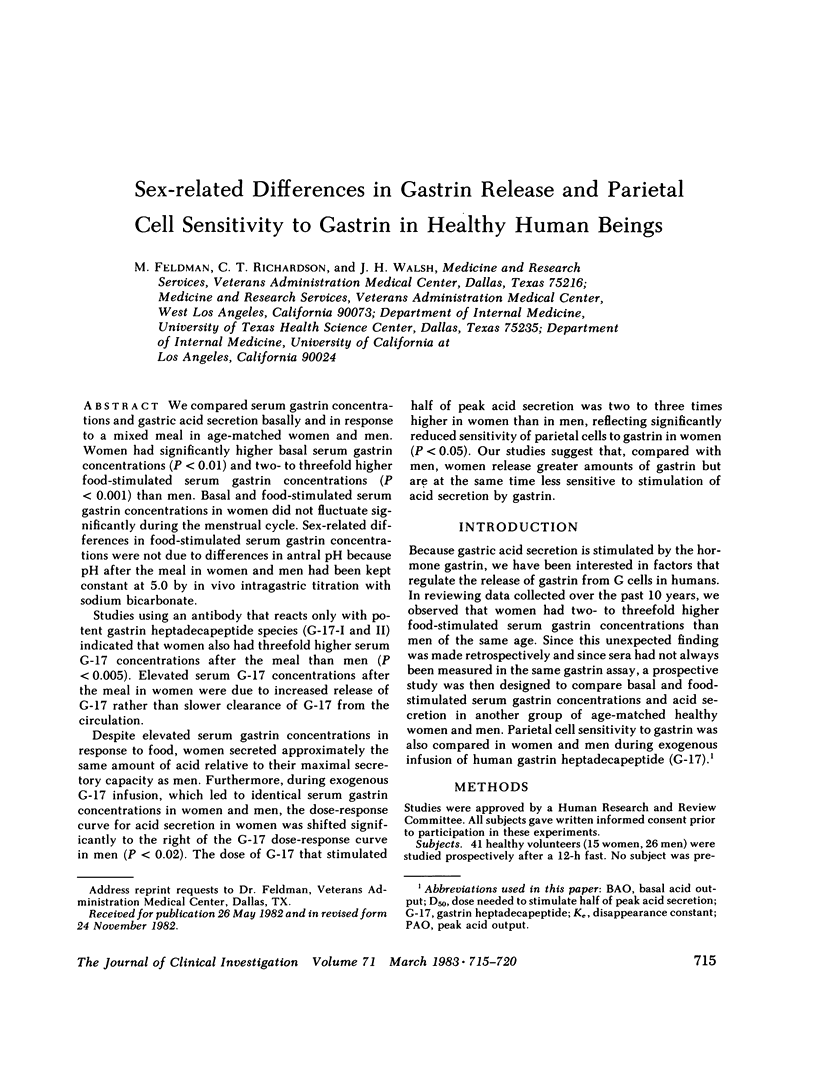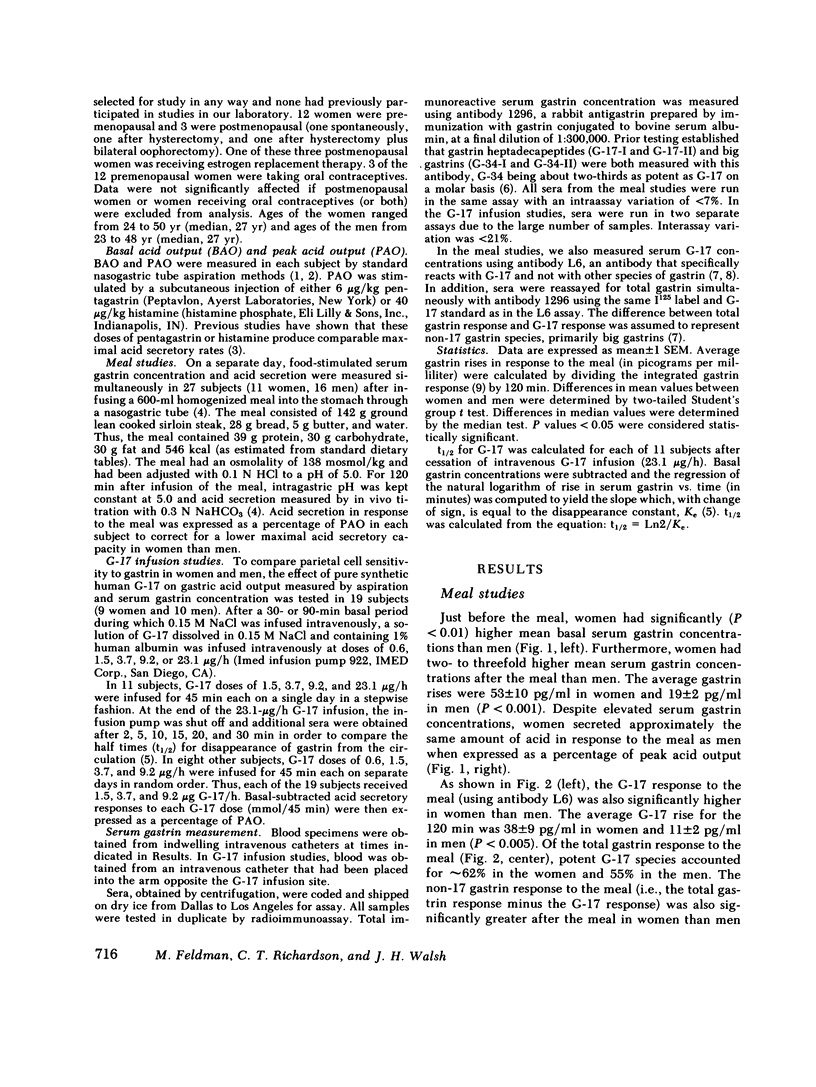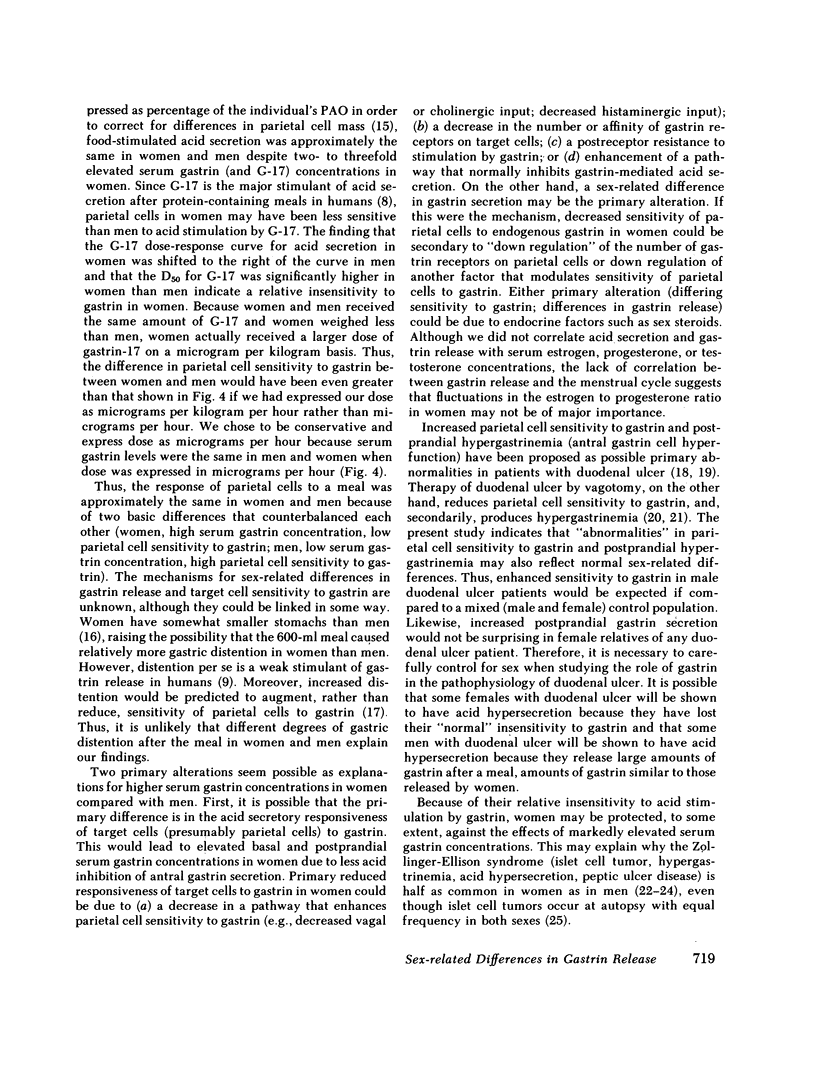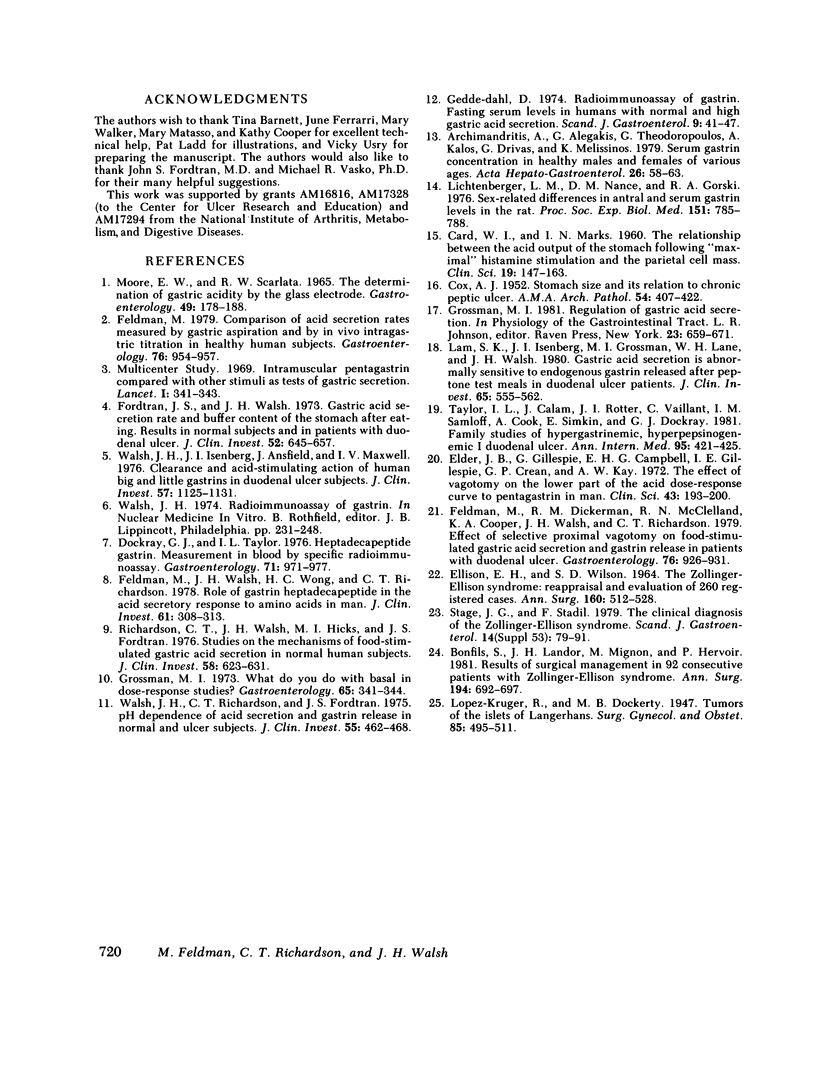Abstract
We compared serum gastrin concentrations and gastric acid secretion basally and in response to a mixed meal in age-matched women and men. Women had significantly higher basal serum gastrin concentrations (P < 0.01) and two- to threefold higher food-stimulated serum gastrin concentrations (P < 0.001) than men. Basal and food-stimulated serum gastrin concentrations in women did not fluctuate significantly during the menstrual cycle. Sex-related differences in food-stimulated serum gastrin concentrations were not due to differences in antral pH because pH after the meal in women and men had been kept constant at 5.0 by in vivo intragastric titration with sodium bicarbonate.
Studies using an antibody that reacts only with potent gastrin heptadecapeptide species (G-17-I and II) indicated that women also had threefold higher serum G-17 concentrations after the meal than men (P < 0.005). Elevated serum G-17 concentrations after the meal in women were due to increased release of G-17 rather than slower clearance of G-17 from the circulation.
Despite elevated serum gastrin concentrations in response to food, women secreted approximately the same amount of acid relative to their maximal secretory capacity as men. Furthermore, during exogenous G-17 infusion, which led to identical serum gastrin concentrations in women and men, the dose-response curve for acid secretion in women was shifted significantly to the right of the G-17 dose-response curve in men (P < 0.02). The dose of G-17 that stimulated half of peak acid secretion was two to three times higher in women than in men, reflecting significantly reduced sensitivity of parietal cells to gastrin in women (P < 0.05). Our studies suggest that, compared with men, women release greater amounts of gastrin but are at the same time less sensitive to stimulation of acid secretion by gastrin.
Full text
PDF





Selected References
These references are in PubMed. This may not be the complete list of references from this article.
- Archimandritis A., Alegakis G., Theodoropoulos G., Kalos A., Drivas G., Melissinos K. Serum gastrin concentrations in healthy males and females of various ages. Acta Hepatogastroenterol (Stuttg) 1979 Feb;26(1):58–63. [PubMed] [Google Scholar]
- Bonfils S., Landor J. H., Mignon M., Hervoir P. Results of surgical management in 92 consecutive patients with Zollinger-Ellison syndrome. Ann Surg. 1981 Dec;194(6):692–697. doi: 10.1097/00000658-198112000-00005. [DOI] [PMC free article] [PubMed] [Google Scholar]
- CARD W. I., MARKS I. N. The relationship between the acid output of the stomach following "maximal" histamine stimulation and the parietal cell mass. Clin Sci. 1960 Feb;19:147–163. [PubMed] [Google Scholar]
- COX A. J. Stomach size and its relation to chronic peptic ulcer. AMA Arch Pathol. 1952 Nov;54(5):407–422. [PubMed] [Google Scholar]
- Dockray G. J., Taylor I. L. Heptadecapeptide gastrin: measurement in blood by specific radioimmunoassay. Gastroenterology. 1976 Dec;71(6):971–977. [PubMed] [Google Scholar]
- ELLISON E. H., WILSON S. D. THE ZOLLINGER-ELLISON SYNDROME: RE-APPRAISAL AND EVALUATION OF 260 REGISTERED CASES. Ann Surg. 1964 Sep;160:512–530. doi: 10.1097/00000658-196409000-00013. [DOI] [PMC free article] [PubMed] [Google Scholar]
- Elder J. B., Gillespie G., Campbell E. H., Gillespie I. E., Crean G. P., Kay A. W. The effect of vagotomy on the lower part of the acid dose-response curve to pentagastrin in man. Clin Sci. 1972 Aug;43(2):193–200. doi: 10.1042/cs0430193. [DOI] [PubMed] [Google Scholar]
- Feldman M. Comparison of acid secretion rates measured by gastric aspiration and by in vivo intragastric titration in healthy human subjects. Gastroenterology. 1979 May;76(5 Pt 1):954–957. [PubMed] [Google Scholar]
- Feldman M., Dickerman R. M., McClelland R. N., Cooper K. A., Walsh J. H., Richardson C. T. Effect of selective proximal vagotomy on food-stimulated gastric acid secretion and gastrin release in patients with duodenal ulcer. Gastroenterology. 1979 May;76(5 Pt 1):926–931. [PubMed] [Google Scholar]
- Feldman M., Walsh J. H., Wong H. C., Richardson C. T. Role of gastrin heptadecapeptide in the acid secretory response to amino acids in man. J Clin Invest. 1978 Feb;61(2):308–313. doi: 10.1172/JCI108940. [DOI] [PMC free article] [PubMed] [Google Scholar]
- Fordtran J. S., Walsh J. H. Gastric acid secretion rate and buffer content of the stomach after eating. Results in normal subjects and in patients with duodenal ulcer. J Clin Invest. 1973 Mar;52(3):645–657. doi: 10.1172/JCI107226. [DOI] [PMC free article] [PubMed] [Google Scholar]
- Gedde-Dahl D. Radioimmunoassay of gastrin. Fasting serum levels in humans with normal and high gastric acid secreation. Scand J Gastroenterol. 1974;9(1):41–47. [PubMed] [Google Scholar]
- Grossman M. I. What do you do with basal in dose-response studies? A suggested answer. Gastroenterology. 1973 Aug;65(2):341–344. [PubMed] [Google Scholar]
- Lam S. K., Isenberg J. I., Grossman M. I., Lane W. H., Walsh J. H. Gastric acid secretion is abnormally sensitive to endogenous gastrin released after peptone test meals in duodenal ulcer patients. J Clin Invest. 1980 Feb;65(2):555–562. doi: 10.1172/JCI109699. [DOI] [PMC free article] [PubMed] [Google Scholar]
- Lichtenberger L. M., Nance D. M., Gorski R. A., Grossman M. I. Sex-related difference in antral and serum gastrin levels in the rat. Proc Soc Exp Biol Med. 1976 Apr;151(4):785–788. doi: 10.3181/00379727-151-39307. [DOI] [PubMed] [Google Scholar]
- MOORE E. W., SCARLATA R. W. THE DETERMINATION OF GASTRIC ACIDITY BY THE GLASS ELECTRODE. Gastroenterology. 1965 Aug;49:178–188. [PubMed] [Google Scholar]
- Richardson C. T., Walsh J. H., Hicks M. I., Fordtran J. S. Studies on the mechanisms of food-stimulated gastric acid secretion in normal human subjects. J Clin Invest. 1976 Sep;58(3):623–631. doi: 10.1172/JCI108509. [DOI] [PMC free article] [PubMed] [Google Scholar]
- Stage J. G., Stadil F. The clinical diagnosis of the Zollinger-Ellison syndrome. Scand J Gastroenterol Suppl. 1979;53:79–91. [PubMed] [Google Scholar]
- Taylor I. L., Calam J., Rotter J. I., Vaillant C., Samloff I. M., Cook A., Simkin E., Dockray G. J. Family studies of hypergastrinemic, hyperpepsinogenemic I duodenal ulcer. Ann Intern Med. 1981 Oct;95(4):421–425. doi: 10.7326/0003-4819-95-4-421. [DOI] [PubMed] [Google Scholar]
- Walsh J. H., Isenberg J. I., Ansfield J., Maxwell V. Clearance and acid-stimulating action of human big and little gastrins in duodenal ulcer subjects. J Clin Invest. 1976 May;57(5):1125–1131. doi: 10.1172/JCI108379. [DOI] [PMC free article] [PubMed] [Google Scholar]
- Walsh J. H., Richardson C. T., Fordtran J. S. pH dependence of acid secretion and gastrin release in normal and ulcer subjects. J Clin Invest. 1975 Mar;55(3):462–468. doi: 10.1172/JCI107952. [DOI] [PMC free article] [PubMed] [Google Scholar]


